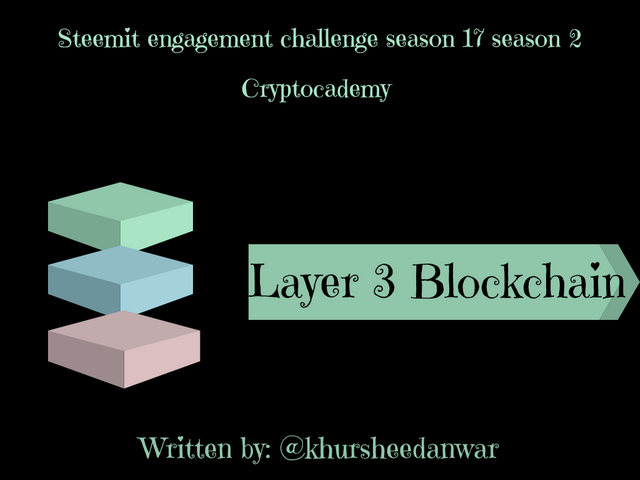
Layer 3 blockchains are basically particular in fractal scalability and they also possesses a modular architectures which permits for scaling. The main components and mechanisms are:
1. Layer 1:
These are particularly decentralized blockchain and in examples there are Bitcoin and Ethereum.
2. Layer 2:
These are basically used for scaling solutions and in examples I have sidechains, off-chain protocols.
3. Layer 3:
These are particular for or act as fractal scaling layer.
- Sharding:Sharing are some parallel transaction processing.
- Prism: Prism is defined as distributed storage of data.
- Fractal Trees: Fractal trees are used for efficient storage of information and for querying.
- Rollups: Roll ups are basically compressed bundles in which there are transactions present.
4. Interoperability Layers:
Interoperability layers allow communication and transfer of tokens between blockchains.
5. Smart Contract Hubs:
If I talk about smart contract hubs then these are basically they are used for execution of centralized smart contract and for their management strategies.
6. Data Availability Layers:
For ensuring information or data proper accessibility and for its persistence data availability layers are used.
Not this is below you can see a chart which I have drawn for showing graphical representation of layer-3 Blockchain architecture.
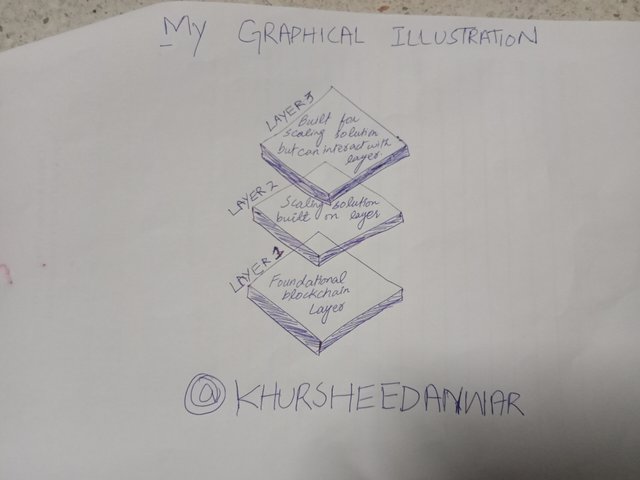
Now this is I am going to brief layer 3 Blockchain architecture in tabular form so that it becomes easy to understand.
| Layer | Component | Mechanism |
|---|---|---|
| Layer 1 | Decentralized Blockchain(No Central authority ) | Mechanism is to provide security and decentralization |
| Layer 2 | Scaling Solutions(Scalability improvement) | Mechanism is to speed up interoperability and to make faster Transactions |
| Layer 3 | Sharding is main component of it | Mechanism of layer 3 Blockchain is in parallel Processing of transactions |
| Prism | Data storing in distributed way | |
| Fractal Trees | Data storage in efficient manner and querying | |
| Rollups | Bundles of transactions in compressed form | |
| Interoperability Layers | Interoperability layers are responsible for communicating in cross-chains. | |
| Smart Contract Hubs | Execution of centralized small contracts. | Mechanism is to manage contracts in secure and efficient manner. |
| Data Availability Layers | Significant approach to Data with persistence also. | Mechanism is again simple to ensure that data is available for anytime. |
Practical examples
- Sharding:
You can imagine that there is a blockchain in which there are hundred nodes and each note is responsible for processing time transactions in each second so when we implement sharding then due to its implementation block chain would be able to process 1000 transactions each second.
- Prism:
In case of prism again you can imagine that there is a distributed database which is responsible for storing data across multiple nodes so implementation of prism wood permit for more fast retrieval and storage of data.
- Fractal Trees:
Similarly we can imagine that there is a picture of hierarchical data structure that can enable data querying in one of the most efficient way just like a file system is in a computer by the implementation of fractal trees.
By processing of transactions in parallel storing and retrieving of data in efficient way and by compressing the transactions and by increasing interoperability and execution of small contract this architecture is able to achieve fractal scalability.
Layer 3 blockchains are specified in fractal scalability by using horizontal sharding for transaction processing capacity improvement by dividing or distribution of the network into smaller, parallel chains which are called shards and they are responsible for processing of transactions in independent way.
Each single shard shows it's responsibility for some particular part of transactions of network so it permits for increase level of throughput.
Now I am going to discuss about its working.
1. Shard creation:
First part related to its working is the creation of shards in which network is divided into different shards of different small size in which each shard possesses it's own set of nodes.
2. Transaction routing:
After that transactions are routed to right shard depending upon the address of a sender or there could also be some other criteria.
3. Parallel processing:
For increase in network throughput each shard have their own specified and assigned transactions in parallel manner.
4. State updates:
Definitely there is also I need of consistency across whole network so for this states of shards remain updated in periodic way for giving surety of consistency across blockchain or network.
This was the approach I have explained generally but it is different from architecture of STEEM blockchain in different ways that I am explaining below;
1. Vertical scaling:
At STEEM Blockchain vertical scaling increasing capacity level of individual nodes for handling more and more transactions in secure way.
2. Witness-based consensus:
At STEEM Blockchain we all know about witness based with consensus algorithm at which this blockchain relies in which there are specified and selected group of nodes responsible for validation of transactions.
3. No sharding:
At STEEM Blockchain there is no implementation of or no use of sharding so it is processing all transactions at single chain.

Practical examples:
- Horizontal sharding:
Again you can suppose that there is a blockchain in which there are hundred nodes which are divided or distributed into 10 shards of 10 nodes each shared have so by the implementation of horizontal sharding each shard able to processes 1000 transactions in one second after the increase in overall network throughput.
- Vertical scaling:
In this case you can again picture that there is a single node which is responsible for handling hundred transactions in 1 second but after the implementation of this it would be upgrade to handle 200 transactions in 1 second.
In layer 3 Blockchain sidechains and rollups are most important for enabling fractal scalability.
Sidechains:
1. Offloading transactions:Offloading transactions are responsible for movement of transactions off the main chain so it cause reduction in overall congestion of main chain and maximize throughput.
2. Interoperability:Interoperability is responsible for enabling transfer of assets or communication from one blockchain to another.
Rollups:
1. Compressing transactions:Rollups are responsible for compression of transactions by making a bundle of transactions into a single one so in this way data storage becomes reduced and transmission needs also minimize.
2. Efficient validation:Rollups use validity proofs so that transactions may get verified in a quick way and in this way computational load or burden also reduces.
Now I going to apply these concepts to STEEM blockchain
1. Sidechains:
• At STEEM blockchain side chains can be implemented for the purpose of some particular use cases like for gaming etc so in this way transactions remain offload which increase throughput in this way.
• If we are enabling interoperability with other blockchain ecosystems then it would be a source of expanding STEEM usage and it's approach.
2. Rollups:
• At STEEM if there is an implementation of rollups for compression and validation of transactions then it would be a cause of reduction in data storage and transmission requirements or needs.
• Roll ups implementation would increase and maximize ability of STEEM blockchain blocks so in this way permitting for occurrence of more transactions to be processed and help out in improvement of network performance.
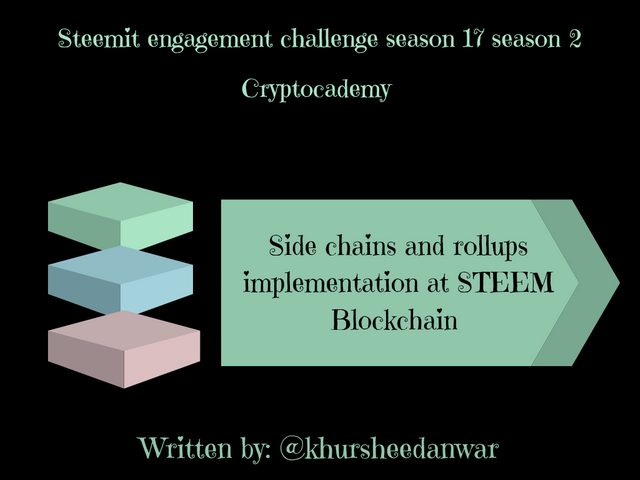
Practical examples:
- Sidechains:
Suppose that there is an STEEM based gaming platform which is offloading it's transactions to a side chain so it would reduce congestion at main network in this way by giving a maximize throughput.
- Rollups:
Now again image that STEEM blockchain is compressing 100 transactions in a rollup so you can think with common sense now that data storage and transmission requirements are going to reduce now and STEEM network efficiency is going to increase.
Now by the integration of sidechains and rollups Steem can be able to
- Improving scalability and throughput at overall network.
- Results in enhancement of interoperability with other blockchain.
- Maximization of STEEM network efficiency and its performance.
- Be supportive for a diverse range of use cases and applications.
Layer 3 blockchain are helpful in handling of decentralized governance by maintaining fractal scalability through different significant things I am explaining below;
1. Modular architecture:There is an modular architecture which causes separation in governance, scalability, and security into different particular distinct layers so it in return permitting for for development and optimization in independent way.
2. Decentralized decision-making:If there's an implementation of voting mechanisms like as an example you can say that there is voting which is token based then it would result in enabling of decentralized decision-making.
3. Autonomous governance protocols: By the utilisation of smart contracts governance process becomes automated with the addition of transparency ensurance.
4. Fractal governance:By implementation of fractal principles to governance it permits for structures at different scales that are self similar decision making.
5. Community engagement:Implementation of engagement of community is safe way is able to foster active involvement of community in governance through different kind of participation mechanisms.
Now I am going to compare STEEM governance structure with it
1. Witness-based consensus:We all know about reliance of STEEM blockchain on some particular groups of witnesses that are responsible for validation of transactions and for decision making processes.
2. Steem Power:STEEM governance structure is using reputation system in which users' influence is considered directly proportional to holdings of STEEM they have in their wallet and with period of their vesting.
3. Community voting:At STEEM users are able to give votes to witnesses and to different proposals which may also have significant impact at direction of blockchain.
We all know that STEEM governance structure is decentralized and community-driven but when we talk about layer 3 blockchains they are then offerjng more advanced and flexible governance mechanisms which is causing to enable;
- Much better decision-making in efficient way.
- Improved level of scalability and adaptability
- Enhancement in community engagement and participation
- Maximization in transparency and accountability
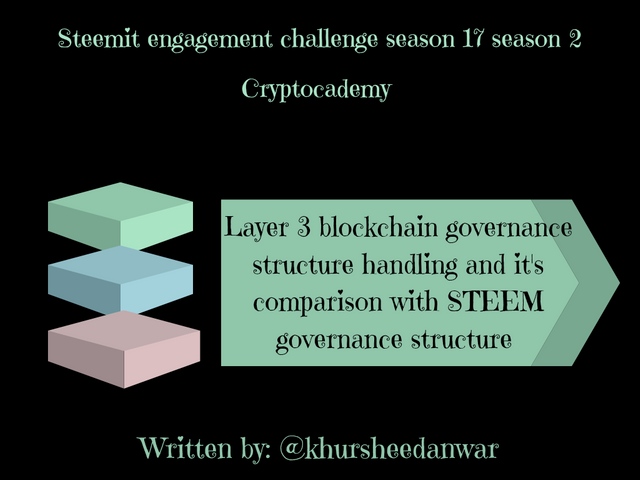
Practical examples:
- Modular architecture:
Suppose that there is layer 3 blockchain which possesses separate layers for governance, scalability, and security so it would in return permit for development and optimization in independent way.
- Decentralized decision-making:
Now suppose there's a scenerio in which there is a layer 3 blockchain and it is using voting mechanisms based on token weighted so it would increase chances of enabling users for voting on those proposals that are related to their token holdings.
The introduction of new technologies like sharding and interoperable blockchains can significantly impact the future of layer 3 blockchains specialized in fractal scalability:
1. Sharding:
**- Increased scalability:**Sharding is helpful in enabling parallel processing which permits layer 3 blockchains in handling increase amount of transactions and it also maximize throughput.
**- Improved resource allocation:**Sharding is a process which is responsible for allocation of more efficient resources which in return enables layer 3 blockchain in optimizing use of resources and minimizing congestion.
2. Interoperable blockchains:
**- Seamless communication:**If I talk ship Interoperable blockchains then they allow and enable layer 3 blockchains to have a communication system and exchange data system with other blockchain that foster in return a most connected blockchain landscape.
**- Enhanced utility:**Interoperability is responsible for enhancement of expanding the use of layer 3 blockchains which enable them to show their interaction with a wide range of applications and diverse use cases.
For adapting these developments STEEM blockchain can;
1. Implement sharding:STEEM blockchain can distribute network in small, parallel chains which are called shards of increasing overall throughput and for improvement and enhancement of resource allocation.
2. Develop interoperability protocols:STEEM blockchain can create protocols for enabling the communication to be seamless and data exchange with other blockchain which can expand use of STEEM and can make it more accessible everyone so make it more popular.
3. Integrate with other blockchains:STEEM can use interoperable blockchains for connecting Steem with other blockchain which is a source and cause to enable new use cases and applications.
4. Upgrade smart contract functionality:STEEM blockchain is used for enhancement of STEEM smart contract capabilities for taking advantage of sharding and interoperability which enable more advanced and scalable applications.
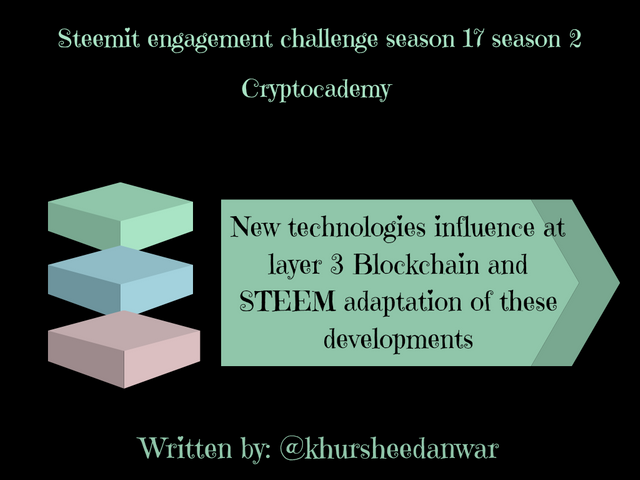
Practical examples:
- Sharding:
Suppose that there are 10 shards in which STEEM blockchain is divided and each shard is processing 100 transactions in one second so after increase in throughput of network there would be processing of 1000 transactions in one second.
- Interoperability:
For this you can imagine that STEEM Blockchain is connected with Ethereum blockchain and in this way it is enabling a connection between these two networks and causing transfer of assets from one blockchain to another.
By embracement of these technologies STEEM blockchain can maintain its position as a layer 3 blockchain and can continue it's growing journey in this advancing blockchain landscape.
.png)
Upvoted. Thank You for sending some of your rewards to @null. It will make Steem stronger.
Downvoting a post can decrease pending rewards and make it less visible. Common reasons:
Submit
Thanks 😊
Downvoting a post can decrease pending rewards and make it less visible. Common reasons:
Submit
@tipu curate
Downvoting a post can decrease pending rewards and make it less visible. Common reasons:
Submit
Upvoted 👌 (Mana: 5/7) Get profit votes with @tipU :)
Downvoting a post can decrease pending rewards and make it less visible. Common reasons:
Submit
Thank you for upvote
Downvoting a post can decrease pending rewards and make it less visible. Common reasons:
Submit
Your article I did read about the layer-3 blockchain and how they get big is awesome. It isn't boring because you present these layers with an explanation like Layer 1 for Bitcoin and Ethereum, Layer 2 for more functionality and Layer 3 for ultra-level scaling.
The points about sharding, prims for storage, fractal trees for saving data, and rollups for squeezing the transactions in a decentralized system is also easy to comprehend. It is fascinating that layer 3 blockchains employ horizontal fork into different chains to be able to processed many transactions at one time. However, if you compare this with Steem blockchain, you can see a great dissimilarity between Steem's way of decision by witnesses and Steem's way of doing thigns by moving up instead of doing things sideways.
The idea about sidechains and rollups to make Steem just that much better that it is is smart and shrewd. Came last, the one about the capability of layer 3 blockchains and Steemit to make the decisions of the community and incorporate it seems interesting. You created a good content.
Downvoting a post can decrease pending rewards and make it less visible. Common reasons:
Submit
I am happy that you love layer 3 blockchain architecture explained by me and I am happy that my content was not boring to read and to see overall for you because I really wrote it with a lot of efforts by making little points.
I am happy that you really like the points about sharding, prims for storage, fractal trees for saving data, and rollups for squeezing the transactions in a decentralized system and it's really true that all these things are positivity of layer 3 blockchain.
You really like my ideas about side chain and rollups.I wish much success too you too.
Thank you for praising my content...
Downvoting a post can decrease pending rewards and make it less visible. Common reasons:
Submit
Wishing you continued success as well bro and thank you for the kind words
Downvoting a post can decrease pending rewards and make it less visible. Common reasons:
Submit
Thank you Soo much for wishing success...
My pleasure to leave kind words at your post
Downvoting a post can decrease pending rewards and make it less visible. Common reasons:
Submit
Your most welcome 😊 thanks for this kindness
Downvoting a post can decrease pending rewards and make it less visible. Common reasons:
Submit
Saludos cordiales estimado amigo khursheedanwar, un gran placer para mi saludarte, leer y comentar tu participación.
Ya sabemos que las Blockchain de capa 3 vienen a solucionar varios problemas, principalmente la escalabilidad.
Buena participación amigo.
Te deseo una feliz, bonita y bendecida noche.
Downvoting a post can decrease pending rewards and make it less visible. Common reasons:
Submit
Greetings to you my friend yancar .
It's again my happiness and joy to warmly welcome you at my post and I am happy that as usual you are loving to comment at my participation.
I agree that layer 3 blockchain have its main concern to solve scalability issues by using different interesting approaches.
Thank you for wishing me a blessed day ,but unfortunately I am responding you later as due to elections at district level internet services were unavailable.
Downvoting a post can decrease pending rewards and make it less visible. Common reasons:
Submit
Greetings my friend, Your breakdown of layer 3 blockchains is fantastic! Explaining sharding and rollups in a decentralized system is 👌. All the best in the contest, success for you👍
Downvoting a post can decrease pending rewards and make it less visible. Common reasons:
Submit
Greetings to you.
Welcome brother at my post and thank you for coming here.
You truly understood about my layer 3 blockchain architecture breakdown and I am hopeful that you have also loved my graphical representation.
Most specifically you are talking about sharding and rollups which I really like.
Thanks for wishing me success.
Downvoting a post can decrease pending rewards and make it less visible. Common reasons:
Submit
Wow after going to your article I must say you left me speechless and amazed because I wonder how on Earth can an individual embed such high quality knowledge about cryptocurrency, indeed I must say to you is an honor and a pleasure learning deeper knowledge on scalability and blockchain architecture.
Thank you very much friend for going through all the difficulties and stress just to come up with this quality article, on your free time I will appreciate you dropping a comment on my entry to the link below https://steemit.com/hive-108451/@starrchris/sec-s17-w2-or-or-layer-3-blockchain
Downvoting a post can decrease pending rewards and make it less visible. Common reasons:
Submit
That's great if you are speechless and amazed by reading the concepts I have delivered to you about layer 3 blockchain.
You are feeling very honored by reading my content and by getting knowledge about concepts explained by me.
Most welcome friend because in past it has been my record to share quality content so again in future I would try my best to produce quality content.
I have visited your entry and it was as amazing as your comment is
Downvoting a post can decrease pending rewards and make it less visible. Common reasons:
Submit
Modular architecture:There is an modular architecture which causes separation in governance, scalability, and security into different particular distinct layers so it in return permitting for for development and optimization in independent way.
best of luck dear
Downvoting a post can decrease pending rewards and make it less visible. Common reasons:
Submit
Thanks for your comment.
You have described one of my point already described by me and it is modular architecture and I think definitely you like it most from my post and may be it seems to be unique to you.
Thank you for wishing me good luck 🤞.
I wish same for you ...
Downvoting a post can decrease pending rewards and make it less visible. Common reasons:
Submit
Greetings friend,
I'm speechless and amazed at how you managed to pack so much incredible knowledge about cryptocurrency into your post. Learning about scalability and blockchain architecture from you has been such an honour and pleasure. I can not thank you enough for putting in all the hard work and effort to create such a high-quality article as I know myself the demand to come up with such. It is people like you who make learning about these topics so exciting and accessible. Keep up the amazing work and all the best, my friend.
Downvoting a post can decrease pending rewards and make it less visible. Common reasons:
Submit
Greetings to you too!
You are not confined to one specific point of my post and you have given your generalized overview about my post and it seems that you love my each and every point because you are thinking that I have grip at concepts I have delivered here about layer 3 architecture.
I agree that cryptocurrency and blockchain knowledge is very diverse and advanced and np one can have a complete grip on it but we all are here in this community for learning and understanding new concepts and I am happy that through passing from this learning phase I am learning something new day by day
Thank you for being here at my post.
Downvoting a post can decrease pending rewards and make it less visible. Common reasons:
Submit
You are welcome friend, always a pleasure learning from you.
Downvoting a post can decrease pending rewards and make it less visible. Common reasons:
Submit
Thank you Soo much for responding back.
It means a lot for me ☺️
Stay blessed 💕
Downvoting a post can decrease pending rewards and make it less visible. Common reasons:
Submit